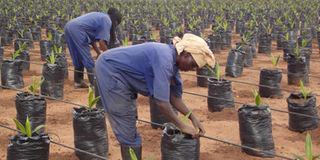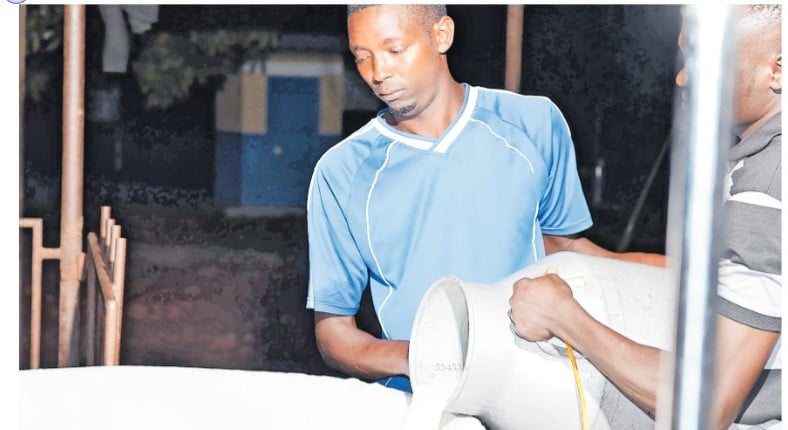Prime
Northern Uganda to grow oil palm to meet market demand

Workers in an oil palm field Prepare seedlings in Kiryandongo District. PHOTO BY MICHAEL J. SSALI
Farmers in northern Uganda will have growing oil palm as an alternative economic activity to supply a palm oil extraction plant that is to be set up in Kiryandongo by 2017.
Tony Gadhoke, chief executive officer, Mukwano Group of Industries, says the plant will be installed in June 2016.
Outgrowers
The company has devoted hundreds of hectares of land to oil palm but will still need outgrowers, just as it is for sunflower, soya bean and maize.
The palm oil is to be used for making cooking oil and other products to satisfy the market in East and Central Africa.
Under the supervision of William Botha, farm manager at Kiryandongo, there is planting oil plam and potting of seedlings. The latter are imported from Costa Rica.
Challenge
“We have planted about 750 acres and we intend to have at least 3,000 acres of our own land under the crop,” he says. “We expect to get the rest of the raw material from outgrowers.”
Ideally, at least 100,000 acres is needed. Thousands of small-scale farmers are the option to fill the gap.
Botha added that one challenge is that the north has a long dry period yet palm trees need a lot of rain. “We engaged a consultant from Costa Rica who recommended a hybrid high-yielding species that can grow in those conditions. We also plan to do irrigation,” he said.
Robert Adwek, the field operations manager, adds: “Growing oil palm in northern Uganda is not new. Previous governments had the idea and it is why you will see oil palm trees here and there. The programmes were interrupted by prolonged political disturbances that we have gone through. Otherwise the region has a big potential for producing the crop.”
Assured market
One of the reasons most farmers have not benefitted sufficiently from their occupation is that they have produce crops but are uncertain about where to sell them and at what price.
However under contract farming arrangements with large manufacturing companies and cooperatives, farmers are assured of a market. They know the price at which they will sell, so they can plan their activities better.
Districts in the north are going into oil palm around the time when Rakai, Kalungu and Masaka districts are also turning to the crop, following indications of how the farmers in Kalangala District have benefitted.
Productive
According to David Mukasa Balilonda, the district production coordinator, Kalangala, a household with an acre of oil palm earns Shs580,000 every month.
Fifty eight oil palm trees are planted per acre and a bunch of oil palm nut is harvested from each tree every month on average. Some trees sometimes produce two bunches in a month, which are ready for harvest.
An oil palm tree may be productive for up to 40 years but farmers are advised to replace it at 25-30 years when it becomes too tall for safe climbing to harvest the bunches.
It takes a little over a year to prepare an oil palm seedling and it costs Shs15,000 to produce one.
That is the amount outgrowers are likely to pay for each seedling when they start planting oil palm.
For several years, Mukwano company has involved external growers in the production of sunflower, soya bean and maize.
Extra land
This is in Masindi, Kiryandongo, Apac, Kole, Lira, Oyam, Nwoya, Aleptong, Otuke, Dokolo, Amolatar, Kaberamaido, Agago and Pader. These are some of the districts where farmers are engaged as outgrowers.
“We plan to initially set up model farms in the various districts for the farmers to copy from,” Botha points out.
The idea is to persuade the farmers that they have been working with and who have extra land to begin growing oil palm. It followed after them being provided with the necessary training.
Advice
“We realise that it takes some two or three years of waiting before the farmer begins to harvest. So, we will not ask them to put all their land for oil palm production,” he notes.
For instance, a farmer with five acres of land will be advised to begin with three acres as he or she continues to grow sunflower and other crops in the other two acres for income generation as he or she waits for oil palm to mature.
When they attain maturity, the farmer will begin harvesting bunches every month, which the company will buy from him or her.




